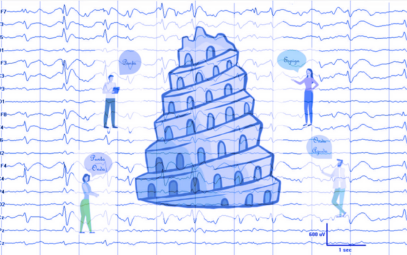The Tower of Babel: Translating the ICU-EEG Nomenclature in Spanish
Published on: May 18, 2023

In the last few decades, continuous electroencephalography (cEEG) has become increasingly adopted as part of the standard management of critically ill patients in many centers. 1,2 The use of cEEG has grown in large part due to the increasing recognition that most acute symptomatic seizures (ASyS) are solely electrographic and do not have detectable clinical signs at the bedside.3 Similarly, there has been a greater awareness of previously described EEG patterns such as lateralized periodic discharges (LPDs), Lateralized rhythmic delta activity (LRDA), and generalized periodic discharges (GPDs), which are critically important patterns due to their association with seizure risk or outcome.4,5
In response to these findings, the American Clinical Neurophysiology Society (ACNS) proposed new terminology in 2005 to improve scientific communication and establish a consistent approach to studying ictal-interictal continuum (IIC) patterns.6 The initial establishment of ACNS critical care EEG terminology made some key changes, which included removing the word epileptiform from the names of these discharges to highlight the uncertainty regarding their underlying association with seizures. The ICU-EEG literature has continued to grow, and the most recent revision of the terminology last year introduced definitions for other observed patterns, such as cyclic alternating pattern of encephalopathy (CAPE), brief potentially ictal rhythmic discharges (BIRDs), and multifocal lateralized periodic discharges.7
The increase in cEEG utilization that has paralleled efforts to create a standardized nomenclature has led to more interest in the topic across the globe, including in non-English speaking countries. However, while the ICU EEG nomenclature has an acceptable interrater reliability for the main terms,8 they have so far only been used in English, limiting the extrapolation of scientific knowledge to Spanish-speaking countries and other non-English speaking settings.
The lack of a common Spanish language terminology to communicate cEEG findings amongst Spanish-speaking colleagues is a challenge akin to the one that prompted the development of the original English language cEEG nomenclature. This need catalyzed the formation of the “Consorcio Hispano de Monitoreo Encefalografico,” a group formed by Hispanic physicians coming from Spain, North, Central, and South America. The goal of this group is to translate the English version of the cEEG nomenclature into Spanish to promote research and collaboration with and among Spanish-speaking countries, and to further promote academic diversity in our field.
Due to the nature of the Spanish language and its regional variations, a consensus between different geographical regions was thought necessary to reflect the most accurate terms that would be more broadly accepted in the diverse Spanish communities where it is intended to be applied. To reflect this diversity, we are working with physicians who are members of the neurology, epilepsy, and neurophysiology societies in several countries to help us achieve a more generalizable Spanish translation of the ICU-EEG nomenclature.
We have also decided to follow a rigorous methodology for the translation process that follows qualitative methodologic principles, rather than simply submitting the original English language document to a translation service. The first step was creating three working subgroups to iteratively translate each nomenclature section. The sections were 1) EEG background, 2) periodic and rhythmic patterns, and 3) electrographic and electroclinical seizures. Each subgroup met regularly to discuss progress with the translation. During those meetings, specific terms were recognized as especially challenging to translate given the vast amount of Spanish terms that are used for a given word. When a subgroup-level consensus for a Spanish term was not reached, a general group-level meeting was organized, where we discussed the Spanish translation options and kept the words that were more frequently used. The discussion of all subgroup and general group-level meetings were recorded in a tracking document.
The next step in this process will be the creation of focus groups with professionals residing in Spanish-speaking countries to obtain a consensus of individuals who will use the nomenclature in their local settings. This is a work in progress, and we are still recruiting volunteers for the focus groups. If you are a potential target audience for the Spanish version of the nomenclature and are interested in contributing to the focus groups, we encourage you to fill out this form.
References
1. Ney, J. P., Van Der Goes, D. N., Nuwer, M. R., Nelson, L. & Eccher, M. A. Continuous and routine eeg in intensive care: Utilization and outcomes, United States 2005- 2009. Neurology 81, 2002–2008 (2013).
2. Hill, C. E. et al. Continuous EEG is associated with favorable hospitalization outcomes for critically ill patients. Neurology 92, E9–E18 (2019).
3. Claassen, J. et al. Detection of electrographic seizures with continuous EEG monitoring in critically ill patients. Neurology 62, 1743–1748 (2004).
4. Rodriguez Ruiz, A. et al. Association of Periodic and Rhythmic Electroencephalographic Patterns With Seizures in Critically Ill Patients. JAMA Neurol 30329, 1–8 (2016).
5. Zafar, S. F. et al. Effect of epileptiform abnormality burden on neurologic outcome and antiepileptic drug management after subarachnoid hemorrhage. Clin Neurophysiol 129, 2219–2227 (2018).
6. Hirsch, L. J. et al. The ACNS Subcommittee on Research Terminology for Continuous EEG Monitoring: Proposed standardized terminology for rhythmic and periodic EEG patterns encountered in critically ill patients. Journal of Clinical Neurophysiology 22, 128–135 (2005).
7. Hirsch, L. J. et al. American Clinical Neurophysiology Society’s Standardized Critical Care EEG Terminology: 2021 Version. doi:10.1097/WNP.0000000000000806.
8. Gaspard, N. et al. Interrater agreement for Critical Care EEG Terminology. Epilepsia 55, 1366–73 (2014).